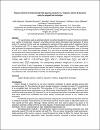Reaction kinetics of carbon dioxide with aqueous solutions of l-Arginine, Glycine & Sarcosine using the stopped flow technique
| المؤلف | Mahmud, Nafis |
| المؤلف | Benamor, Abdelbaki |
| المؤلف | Nasser, Mustafa S. |
| المؤلف | Al-Marri, Mohammed J. |
| المؤلف | Qiblawey, Hazim |
| المؤلف | Tontiwachwuthikul, Paitoon |
| تاريخ الإتاحة | 2017-06-01T07:11:18Z |
| تاريخ النشر | 2017-08 |
| اسم المنشور | International Journal of Greenhouse Gas Control |
| المعرّف | http://dx.doi.org/10.1016/j.ijggc.2017.05.012 |
| الاقتباس | Nafis Mahmud, Abdelbaki Benamor, Mustafa S. Nasser, Mohammed J. Al-Marri, Hazim Qiblawey, Paitoon Tontiwachwuthikul, Reaction kinetics of carbon dioxide with aqueous solutions of l-Arginine, Glycine & Sarcosine using the stopped flow technique, International Journal of Greenhouse Gas Control, Volume 63, August 2017, Pages 47-58 |
| الرقم المعياري الدولي للكتاب | 17505836 |
| الملخص | The use of amino acids as potential solvents for carbon dioxide (CO2) capture has been considered by a number of researchers. However, very little is known about the kinetics and mechanism of amino acids-CO2 reactions. In this work, we investigate the reactions of three amino acids (l-Arginine, Glycine and Sarcosine) with CO2 in aqueous media using stopped-flow conductivity technique. The experiments were performed at temperatures between 293 and 313K and amino acids concentrations were in the range of 0.05–0.2 molar. The overall rate constants (kov) was found to increase with increased amino acid concentration and solution temperature. Both zwitterion and termolecular mechanisms were used to model and interpret the data. However, the Zwitterion mechanism was found to be the preferred one. From the stopped-flow results at pH around 6, we found that neutral l-Arginine, Glycine and Sarcosine react with CO2(aq) with k(M−1s−1)=2.81×1010exp(−4482.9T(K)), k(M−1s−1)=3.29×1013exp(−8143.7T(K)) and k(M−1s−1)=3.90×1013exp(−7991.0T(K)) respectively. The corresponding activation energies are 37.28kJmol−1, 67.71kJmol−1 And 66.44kJmol−1 respectively. A comparison between the kinetics of the three amino acids showed that Arginine exhibits highest reaction rate with CO2 followed by Sarcosine and then Glycine. The technique and results obtained from this work can be used as strong tools in the development of efficient new solvents for the removal of CO2 from flue and industrial gases. |
| راعي المشروع | This paper was made possible by an NPRP Grant # 7-1154-2-433 from the Qatar National Research Fund (a member of Qatar Foundation). |
| اللغة | en |
| الناشر | Elsevier |
| الموضوع | Carbon dioxide Glycine Arginine Sarcosine Kinetics Stopped flow technique |
| النوع | Article |
| الصفحات | 47-58 |
| رقم المجلد | 63 |
تحقق من خيارات الوصول
الملفات في هذه التسجيلة
هذه التسجيلة تظهر في المجموعات التالية
-
الهندسة الكيميائية [1172 items ]
-
الأبحاث [494 items ]



